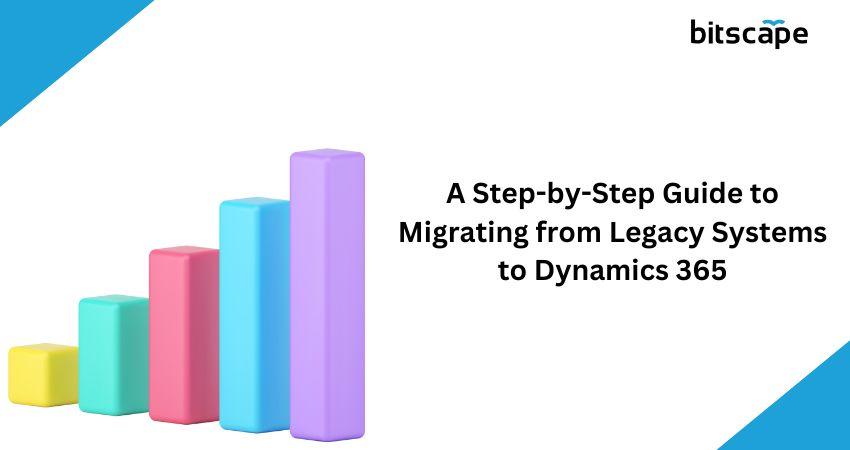In today’s digital age, organisations need to be more agile and nimble in order to remain competitive. Legacy systems are typically the hindrance for this. They slow down processes, hamper access and control, and prevent employees from working faster. And if your company is anything like most others, by now you’ve probably acquired a multitude of legacy software solutions across different departments and functions. Consequently, keeping track of everything gets more and more difficult. There is, however, still hope! With Microsoft Dynamics 365 for Business , you can streamline your processes while modernising the way that your organisation communicates with one another and customers. In this blog post, we will discuss what Microsoft Dynamics 365 for Business is, how it differs from other software systems like Microsoft Office 365 or SharePoint , and how to implement it in your company. Keep reading to find out more information on the benefits of migrating from legacy systems to Dynamics 365 for Business as well as some common pitfalls you should avoid when doing so.
What is Microsoft Dynamics 365 for Business?
A cloud-based enterprise resource planning (ERP) and customer relationship management (CRM) system is provided by Microsoft under the name Dynamics 365 services for Business. It provides businesses with a suite of integrated applications to manage their operations, including financials, supply chain, project management, customer service, and sales. The solution is designed to streamline and automate key business processes, provide insights and intelligence, and help organisations better engage with their customers and make data-driven decisions.
Benefits of migrating to Dynamics 365 for Business
- Improved efficiency and productivity: Dynamics 365 streamlines and automates key business processes, reducing manual tasks and freeing up time for more strategic activities.
- Enhanced customer engagement: The solution provides a centralised view of customer interactions and data, allowing organisations to better understand their customers and improve engagement.
- Increased visibility and insights: Dynamics 365 provides real-time data and intelligence, allowing organisations to make informed, data-driven decisions and improve business performance.
- Greater flexibility and scalability: The solution is delivered as a cloud service, providing organisations with greater flexibility to access and use the applications they need, when they need them, and scale their solutions as their business grows.
- Lower total cost of ownership (TCO): Dynamics 365 is more cost-effective than traditional on-premises solutions, as it eliminates the need for hardware and IT infrastructure and reduces ongoing maintenance costs.
- Integration with other Microsoft solutions: Dynamics 365 integrates with other Microsoft solutions such as Office 365, Power Platform, and Azure, enabling organisations to maximise the value of their existing investments.
Here are some common pitfalls to avoid when migrating from legacy systems to Microsoft Dynamics 365 for Business:
- Not properly assessing current systems and processes: Before migrating, it’s important to fully understand your current systems, processes, and data. This will help ensure that you have a clear plan for the migration and can avoid potential issues.
- Neglecting data quality: Legacy systems often contain inaccurate or outdated data, so it’s important to clean and standardise your data before migrating to ensure accurate and consistent information in Dynamics 365 migration services.
- Not involving stakeholders: Successful migrations require buy-in from all stakeholders, including IT, business users, and executives. Neglecting to involve them in the process can lead to resistance and slow adoption.
- Underestimating the time and effort required: Migrating from legacy systems can be complex and time-consuming, so it’s important to allocate sufficient resources and plan for the necessary time and effort.
- Not testing and verifying the solution: Before going live, it’s critical to thoroughly test the solution and verify that it meets your requirements and expectations.
- Not considering future needs: It’s important to think about your organisation’s future needs and ensure that the solution you choose is flexible and scalable enough to accommodate future growth and change.
- Neglecting training and support: Proper training and ongoing support are essential to ensuring successful adoption and continued success with Dynamics 365.
Microsoft Office 365 and SharePoint
SharePoint as well as Microsoft Office 365 Word, Excel, PowerPoint, and other well-known Microsoft Office programs are part of the subscription-based online office and productivity package known as Microsoft Office 365.
Integrated into the Microsoft Office 365 package, SharePoint is a web-based platform for document management and collaboration. It enables teams to share and manage content, knowledge, and applications to improve teamwork, communication, and decision-making. SharePoint provides features such as document libraries, lists, wikis, blogs, and team sites, as well as business intelligence and enterprise search capabilities.
Together, Office 365 and SharePoint provide organisations with a powerful platform for collaboration, communication, and productivity, allowing teams to work together more efficiently and effectively, regardless of location or device.

As the editor of the blog, She curate insightful content that sparks curiosity and fosters learning. With a passion for storytelling and a keen eye for detail, she strive to bring diverse perspectives and engaging narratives to readers, ensuring every piece informs, inspires, and enriches.










